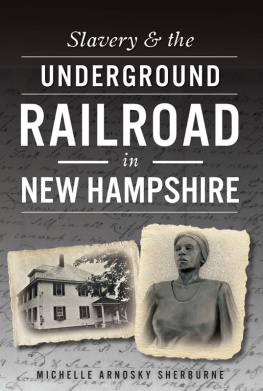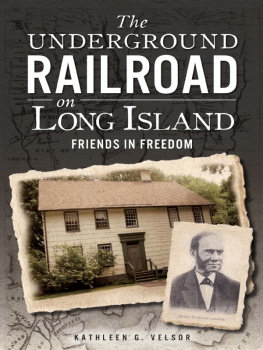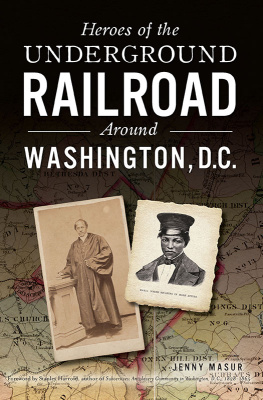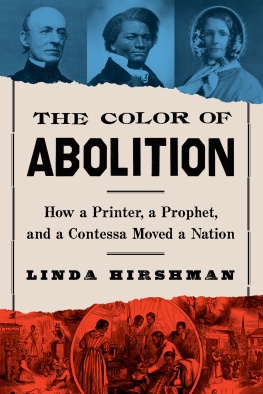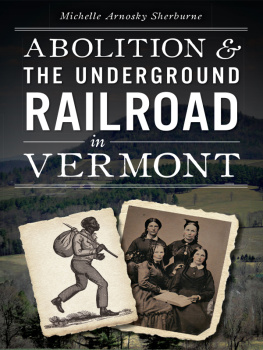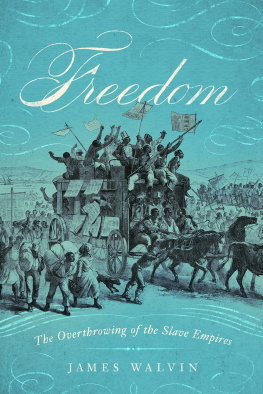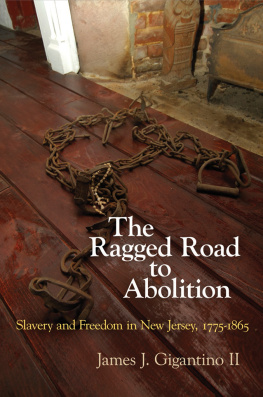
Published by The History Press
Charleston, SC 29403
www.historypress.net
Copyright 2013 by Michelle Arnosky Sherburne
All rights reserved
Front cover: Webster sisters. Courtesy of Bard and Gina Prentiss, tintype in private collection.
First published 2013
e-book edition 2013
Manufactured in the United States
ISBN 978.1.62584.494.1
Library of Congress Cataloging-in-Publication Data
Sherburne, Michelle Arnosky.
Abolition and Vermonts underground railroad / Michelle Arnosky Sherburne.
pages cm
Includes bibliographical references and index.
print edition ISBN 978-1-62619-038-2
1. Antislavery movements--Vermont--History--19th century. 2. Underground Railroad--Vermont--History--19th century. 3. Abolitionists--Vermont--History--19th century. I. Title.
E445.V4S54 2013
306.36209743--dc23
2013029162
Notice: The information in this book is true and complete to the best of our knowledge. It is offered without guarantee on the part of the author or The History Press. The author and The History Press disclaim all liability in connection with the use of this book.
All rights reserved. No part of this book may be reproduced or transmitted in any form whatsoever without prior written permission from the publisher except in the case of brief quotations embodied in critical articles and reviews.
This book is dedicated in memory of my grandmother Mary Eshleman,|
who loved to read anything I wrote.
CONTENTS
ACKNOWLEDGEMENTS
This has been a twenty-one-year journey of delving into the history of Vermonts Underground Railroad for me, and it has kept me captivated.
First and foremost, I thank my husband, Rodney, and son Darren for all their love, support, encouragement and longstanding patience through years of research. To my father and mother, Jim and Deanna Arnosky, thank you for a lifetime of encouragement, love and guidance and for being my constellations.
I have many others to thank: Jutta Scott and Peacham Historical Association for the opportunity to work on their Civil War book project; Peter and Jackie Sinclair for their enthusiasm for my subject and facilitating opportunities for me to lecture; to Ellie Dixon and the Caledonian-Record for that first newspaper assignment about a Haverhill, New Hampshire Underground Railroad safe house that started a lifelong quest; and Connie Sanville, my employer and friend who has given me flexibility to pursue this endeavor.
And thanks go to the wonderful assistance of Bard and Gina Prentiss; Don Papson; Kathy Valloch; Chris Burns at University of Vermont Special Collections; Marjorie Strong and Vermont Historical Society; Steve Leninski; Eric Francis; Donna Zani-Dunkerton of Canaan Historical Society; Martha Howard of Thetford Historical Society; Jennifer Donaldson of Woodstock Historical Society; Jane Williamson of Rokeby Museum; David Warden of Barnet Historical Society; Betty Johnson Gray; Laura Osborn of Upper Valley Life; Robert Pelletier; John Burbank; Susan Ferland of Vergennes Historical Society; Ed Pospicil and Joie Winchell; my sister Amber Maccini for her support; John Fatherley for his history kinship; Denise Williams White and Rosemarie Gillespie; my church family for their support; and Lorna Renfrew for our New York trip and searching for Noahs gravestone in the dark.
Charles E. Metz, architect, is responsible for the beautiful illustrations in this book, and I thank him for his time and patience. Also thanks to Dave Allen of www.old-maps.com whose work with making the Beers, Wallings and Hosea Doton maps available made researching easier. Lastly, thank you to my editor, Whitney Landis, who has helped me stay on track during this project.
It has been a privilege to learn about incredible people who made sacrifices for the Underground Railroad cause. It has been exciting to share about history and make it come to life for others.
Introduction
APPROACH TO UNDERGROUND RAILROAD RESEARCH
We are in the midst of the 150th celebrations of the Civil War, and the Underground Railroad played an important part in our countrys prewar politics and tension. New Civil War artifacts, documents and memorabilia keep surfacing just as new information about the Underground Railroad does. These discoveries give us a better understanding of our countrys history.
The Underground Railroad is an intriguing subject that captures the attention and imagination of young and old. It has all the components of an adventure thriller with the ultimate great endingfreedom for the slaves.
But researching is difficult because of the secrecy and lack of documentation. Researchers do not find complete details like ledger books of fugitives aided or operation details. The Underground Railroad was not about meetings, maps, manuals and membership. The Underground Railroad was a network of people who worked for a common cause within their area. People helped fugitive slaves from one place to another. Once a plan was established, it was used repeatedly, and thus it became organized. Thats the extent of the organization of the Underground Railroad.
People helped strangers because they knew it was the right thing to do. Today, people who help others selflessly receive their fifteen minutes of fame with an interview on CNN or multiple hits on YouTube or Facebook. The heroes who helped the fugitives on their journey didnt get any recognition. All they received was the satisfaction that they had helped. They did their part, and it was out of their hands after that.
Researching the subject is like putting together a large puzzle of safe houses, towns, operators, routes, safety areas and contact information in which the pieces are scattered throughout the Northern states. It is the historians task to gather and reconstruct the history.
We work with the pieces we discovera single journal entry, a story from an agents son, local tradition referring to runaways passing through town, a house with a secret tunnel entrance, an agents letter to a fellow agent about a fugitive on the way. We investigate the clues and leads to determine if there is a connection to the Underground Railroad network. Granted, not every hidden closet or house by a train track was part of the Underground Railroad.
As new accounts and information surface, they shed more light on a realistic picture of nineteenth-century Vermont in terms of the abolitionist movement and the Underground Railroad. Vermont was known as the safe, friendly state, but it was full of intolerance for abolitionists, mobocracy and prejudice against blacks.
We will take a temperature reading of nineteenth-century America and apply it to researching history. We have to remember the time period these people lived in. We cant take the way we think in the twenty-first century and use it to understand history.
Difficulties arise when dealing with the Underground Railroad in New England and especially Vermont because misconceptions exist about Underground Railroad activity. The consensus is that New England was so far north that fugitives were safe and danger nonexistent because they were beyond the reach of their masters and slave catchers.
Through the years, skeptics have tried to change the image of the Underground Railroad. Larry Gara wrote The Liberty Line, which downplayed the role that white abolitionists played in the Underground Railroad and promoted the theory that Underground Railroad memories are no more than exaggerated stories from elderly citizens. Some historians take information out of context and surmise that a new perspective and focus must be applied to the subject based on fragments of information. The problem is that their studies are devoid of context; they ignore the contemporary conditions in the rest of the country, and this is problematic.
Next page


